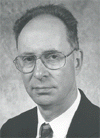|
|
 |
ABOUT THE PRESENTER
|
Frans Spaepen is Gordon McKay
Professor of Applied Physics at Harvard University. He received his
undergraduate degree, in Metallurgical Engineering, at the University
of Leuven in 1971, and a Ph.D. in Applied Physics from Harvard University
in 1975. He joined the faculty of the Division of Applied Sciences
at Harvard in 1977. In 1984 e was a Visiting Professor at the University
of Leuven, and in 2000-01 a Humboldt visitor in Köln and Jülich.
From 1990 till 1998 he was Director of the Harvard Materials Research
Laboratory/Materials Research Science and Engineering Center.
His research interests span a wide range of experimental and theoretical
topics in materials science, such as amorphous metals and semiconductors
(viscosity, diffusion, mechanical properties), the structure and thermodynamics
of interfaces (crystal/melt, amorphous/crystalline semiconductors,
grain boundaries), mechanical properties of thin films, and the perfection
of silicon crystals for metrological applications.
Dr. Spaepen is a Fellow of the American Physical Society, a Fellow
of TMS, and a Foreign Member of the Vlaamse Academie voor Wetenschappen
en Kunsten. He is co-editor of Solid State Physics, Principal editor
of the Journal of Materials Research, and an editorial board member
of a number of materials science journals.
|
INSTITUTE OF METALS LECTURE & ROBERT F. MEHL MEDALIST
Date: Wednesday, February 20, 2002, 12:00 NOON
Location: Sheraton Seattle Hotel & Towers
Room: West Ballroom A
“The Structure of Liquids and Solid-Liquid Interfaces”
 Presented
by: Presented
by:
Frans Spaepen, Harvard University
About the topic:
Identifying the principle that underlies the structure of even the simplest
liquids is an enduring scientific challenge. Starting with the basic facts
about liquids, this talk will critically review the structural models
that have been proposed over the decades. In the picture that emerges,
the liquid is a phase in its own right (not a defective crystal, nor simply
a dense gas) with a polytetrahedral structure. This structural principle
can be used to understand the interface between crystals and liquids and
its role as the barrier for crystal nucleation from the melt.
|

